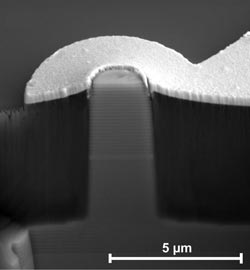Single photons produced electrically

This structure produced at the University of Würzburg using semiconductor material with integrated quantum dot nanostructures emits single photons.<br><br>Image: Institute of Physics, University of Würzburg<br>
For data transmission over the Internet, electrical computer signals are converted into light signals and conducted via fiber optic cables to the recipient.
Once there, they are converted back into electrical signals. These light signals can be tapped into on the cables, enabling unauthorized persons to intercept data without detection. However, this does not go undetected if single light particles, photons, are used for encryption based on quantum cryptography.
With this type of encryption, every single photon is polarized individually in a sequence of light particles – vertically, horizontally, or diagonally. Generally speaking, the type of polarization cannot be captured by a third party without changing it as a result. So, the sender and the recipient would notice immediately if an unauthorized person “eavesdropped” on their data transfer and tried to copy the original state of the light particle.
Lasers as single photon sources have disadvantages
The quantum cryptography technique that is currently applied uses greatly weakened lasers as single photon sources. Even though use of this technique has already begun, there are still considerable disadvantages. “With a weakened laser light single photons are released at completely random times, which means that sometimes several photons are also discharged simultaneously,” explains Sven Höfling from the Institute of Physics at the University of Würzburg.
This could then be exploited by hackers to extract information from the data flow without detection. Consequently, in quantum communication with weakened lasers, complex data transmission procedures have to be adopted to guarantee secure communication.
On the other hand, according to Höfling, an ideal single photon source only ever releases a photon when it is triggered by, for example, an electrical pulse. Physicists from the universities of Würzburg, Munich, and Stuttgart have now succeeded in applying such a single photon source in quantum communication.
Publication in the New Journal of Physics
The scientists are presenting their findings in the New Journal of Physics. One of the keys to their success was the close collaboration between the teams led by Professor Harald Weinfurter in Munich, Professor Peter Michler in Stuttgart, and Professors Martin Kamp and Alfred Forchel in Würzburg.
For their single photon sources, the researchers integrated nanostructures made of semiconductor material into microresonators. These sources are highly likely to emit a single photon with every electrical pulse. By implanting information into the polarization of photons, a key can be produced using quantum cryptography, as the researchers demonstrated in their laboratory experiments.
Quantum communication over longer distances
Of course, the scientists are fully aware that the transmission of photons has to work not just in the laboratory, but also over far greater distances. They have already performed successful work aimed at achieving this in a project funded by the Federal Ministry of Education and Research (BMBF). Within this project, they managed to realize secure quantum communication with electrically powered single photon sources over a free-space test distance of around 500 meters over rooftops in the center of Munich.
However, the scientists from Würzburg, Munich, and Stuttgart want to achieve transmission distances that are far greater than this. They are therefore currently researching building blocks for so-called quantum repeaters as part of a group funded by the BMBF involving other research teams. These are analogous to signal amplifiers in traditional communication technology and are essential for long-distance quantum communication.
“Quantum key distribution using quantum dot single-photon emitting diodes in the red and near infrared spectral range”, Tobias Heindel et al, New Journal of Physics, 2 August 2012, doi:10.1088/1367-2630/14/8/083001
Contact
Dr. Sven Höfling, Institute of Physics at the University of Würzburg, T +49 (0)931 31-83613, sven.hoefling@physik.uni-wuerzburg.de
Media Contact
More Information:
http://www.uni-wuerzburg.deAll latest news from the category: Physics and Astronomy
This area deals with the fundamental laws and building blocks of nature and how they interact, the properties and the behavior of matter, and research into space and time and their structures.
innovations-report provides in-depth reports and articles on subjects such as astrophysics, laser technologies, nuclear, quantum, particle and solid-state physics, nanotechnologies, planetary research and findings (Mars, Venus) and developments related to the Hubble Telescope.
Newest articles

The surprising role of gut infection in Alzheimer’s disease
ASU- and Banner Alzheimer’s Institute-led study implicates link between a common virus and the disease, which travels from the gut to the brain and may be a target for antiviral…

Molecular gardening: New enzymes discovered for protein modification pruning
How deubiquitinases USP53 and USP54 cleave long polyubiquitin chains and how the former is linked to liver disease in children. Deubiquitinases (DUBs) are enzymes used by cells to trim protein…

Machine learning accelerates catalyst discovery
Conceptual blueprint to analyze experimental catalyst data. Machine learning (ML) models have recently become popular in the field of heterogeneous catalyst design. The inherent complexity of the interactions between catalyst…


